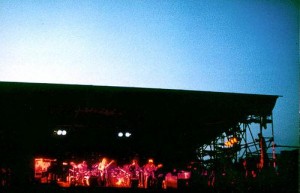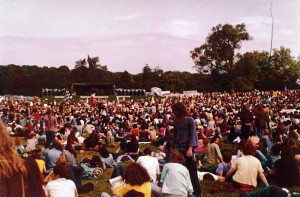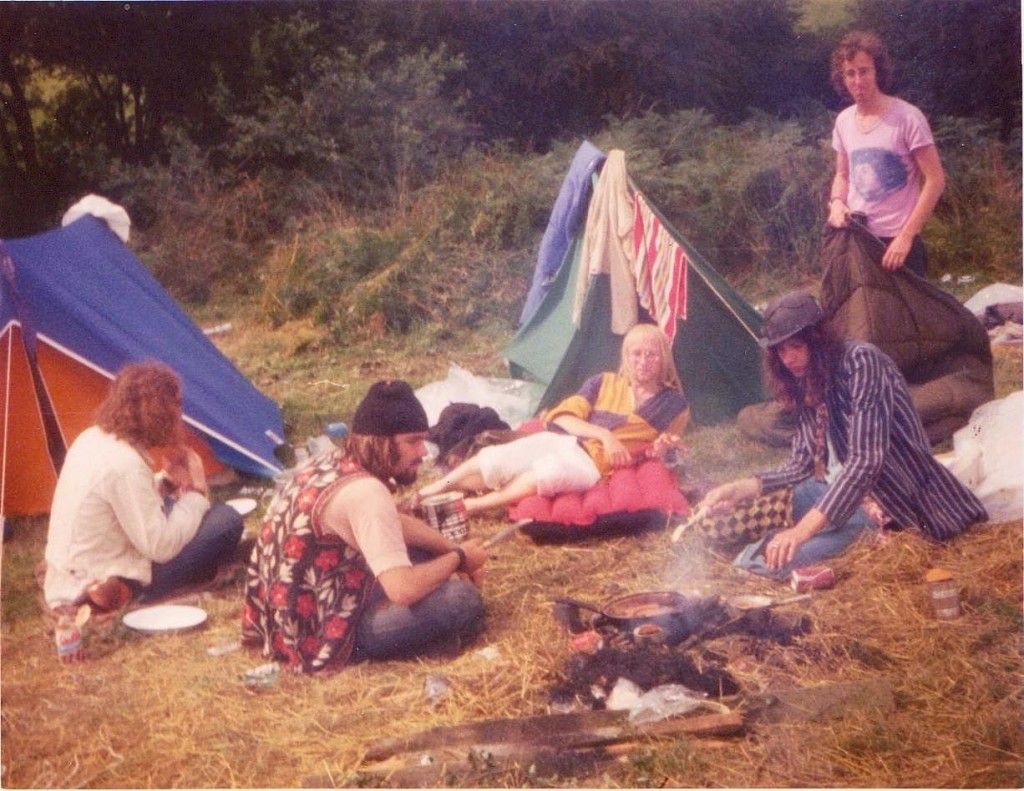How many claps in the theme song for FRIENDS? Or how music, memory, language and wellbeing are powerfully entwined. With help from The Allman Brothers Band, Iggle Piggle, Mr Tumble, James May and the cast of FRIENDS!
Date posted: Thursday 3rd July 2014
 The Allman Brothers Band, Knebworth 20.7.2014 |
 Knebworth 20.7.2014: Where’s Jonesy? |
They say that if you can remember the 1960s then you couldn’t have been there. I was a teenager throughout the 70s and remember it all as if it were yesterday. Actually that’s not quite true- the afternoon and evening of 20th July 1974 are a complete blank.
Like many almost-17-year-olds, in 1974 I was constantly trying to appear older than I actually was. Two of my brothers were at university, so I had a direct line to ideas about what to wear and what to talk about, in the hope that this would give me the edge in the seeming-a-bit-older-than-I-was stakes. The crucial thing for me was to be a step ahead of everyone in my knowledge of which bands were cool and what music to listen to. (Or if I couldn’t afford the albums, to talk about them with some feigned authority). So while my friends were raving about Bowie and The Who, I would break into the conversation with quips like, ‘Well of course there’s a very good reason why The Allman Brothers Band are currently number one in the USA: Brothers and Sisters (their classic double album that I’d never actually heard) is just brilliant!’ Or ‘I’m totally into Van Morrison, The Doobie Brothers and The Mahavishnu Orchestra at the moment.’ (Having only heard Brown Eyed Girl, but having clocked that everyone at university had a copy of Astral Weeks.) In my defence, I did have a lot of theoretical background on The Allman Brothers, including about Duane Allman’s tragic death in a motorcycle accident, closely followed by the same fate for their bass guitarist, and how Duane’s replacement, Richard ‘Dickie’ Betts, had taken the band away from their roots in the blues and into a more country-influenced feel, as exemplified by their brilliant seven-minute instrumental, ‘Jessica’.
Jessica by The Allman Brothers: I was there (in body if not in spirit)
I left school in the summer of 1974 and the first thing I did was get a job, try to grow a beard, and wear faded denim Levi flares, a tie-dye vest and a pair of baseball boots (now known as Converse All Star High Tops). So imagine my excitement when I read in NME that not only were The Allman Brothers Band going to be playing at the first ever one-day festival at Knebworth Park in Hertfordshire, but Van Morrison, The Mahavishnu Orchestra and The Doobie Brothers were also on the bill.
So on the 20th July I packed my hessian shoulder bag with sandwiches, a banana, a flask of tea and a copies of Women in Love by DH Lawrence and Journey to Ixtlan by Carlos Castaneda. (The books were to pretend to read studiously in between each band’s set, in the hope of attracting the attention of girls who would imagine that I was an intellectual who was into Californian mysticism. Believe me, I was neither.) I got on the train at Haslemere and immediately found myself among hundreds of people heading to London, en route for Knebworth. Without further ado I got out my paperbacks and in no time I was feigning intimate knowledge of DH Lawrence and all things Californian with a group of 16-to-17-year-olds from Portsmouth.
I tagged along with Nigel, Clara, Rick, Penny and Jessica for the whole trek to Hertfordshire. Nige showed me his copy of Castaneda’s A Separate Reality, (which he had just started reading), and the lovely Jessica confided that she’d rather die than part with her copy of Sons and Lovers (which she had read six times already). Rick commented on my trendy baseball boots and jokingly tried to get me to swap them for his Doc Martens (we had the same size feet), while Penny offered to trade her Purple Bob Dylan T-shirt for my tie dye vest. (I politely refused, on the pretext that the picture of Bob looked more like Marc Bolan, and I knew better than admit to being a T Rex fan.) Clara kept her counsel, but I could see that she was eyeing up my bag. (Hers was a string bag full of a massive packed lunch, that her mum had forced into her hand as Clara rushed out of her front door. Clara moaned that it made her look like a granny on the way back from the shops. No one complained later as they tucked into the feast of chicken drumsticks, pate, French bread and several Coxes Orange Pippins to share with her friends.) I clicked so well with my new mates that they invited me to hang out with them for the rest of the trip (and I use that word advisedly).
When we finally arrived at Knebworth Park, the place was totally heaving. To get an idea of how squashed we were, have a look at this clip of Pink Floyd playing at Knebworth the following summer. It was virtually impossible to move and even more impossible to find your way back to where you had been sitting, should you have been foolhardy enough to try and find the toilets.
Unfortunately I was foolhardy fool enough, and said goodbye to the gang during the middle of The Sensational Alex Harvey Band’s set. And that’s the last thing I remember about the whole day. When I eventually did begin to remember things again, I was sitting in the waiting room at Haslemere station, being shaken by a member of staff, who told me, “You can’t sleep here all night mate. I’m about to close the station. And is that Marc Bolan on your T-shirt? You ought to know better. ” I had a splitting headache and was wearing a purple Bob Dylan T-shirt, a pair of Dr Martens and clutching a string bag… inside which was Carlos Castaneda’s A Separate Reality a Coxes Orange Pippin and, to my everlasting delight, DH Lawrence’s Sons and Lovers.
To this day, I have no idea what happened. However, whenever I hear the theme tune to Top Gear I am instantly transported to that fateful moment when I went in search of a toilet. This momentary flashback in time always leaves me thinking about the lovely Jessica: wondering if she remembers me at all and if her hair is still red.
I mention all this because I was recently leading a course in Portsmouth. As is my wont, I like to include a music quiz in the proceedings, to illustrate the concept that young children, like adults, enjoy talking about what they already know and, just like us, are trying to make connections with other people who have the same knowledge and interests as them. To prove my point, we listen to clips from theme music from TV programmes and songs featuring in films from the 70s, 80s and 90s, to see who can be the first to recognise what they are. (Amazingly, we only need to listen to a single note on a cello to make several people shout out that it is the opening of the theme music from a 1975 film about a shark.) The younger members of the audience are often a bit sceptical about this activity, until I ask, ‘How many claps are there in the theme song for FRIENDS?’ Several young women will immediately start laughing, shouting out and arguing about whether there are four or five*.
Friends: The one with all the footage from the fountain. Four claps or five?
As I stood in Portsmouth playing Jessica by The Allman Brothers Band, someone did recognise the song for what it was, but was soon drowned out by people associating it with the theme music for Top Gear. If it was my Jessica talking, she certainly didn’t let on.
My point is that we adults build powerful subconscious associations between music and strong emotional experiences. Play the theme to The Jungle Book and many adults will be instantly transported back to the first time they saw that film. The same works for Titanic, Billy Elliot and Grange Hill. These films and TV programmes are part of our individual cultural heritage, in exactly the same way that Something Special and In the Night Garden from BBC’s CBeebies continue to represent the cultural heritage of practically every young child in the UK who watches TV.
In the Night Garden: do you know your Igglepiggle from your Makka Pakka?
When In the Night Garden first appeared, there was a lot of debate about the nonsense the main characters talk. Judging by the hostility it received in the press, it looked like the programme was going to join Bill and Ben the Flowerpot Men, Pingu and Tellytubbies in the list of TV programmes most likely to damage the nation’s children by delaying their language. (I was brought up on The Flowerpot Men and have reasonably well-developed English, though I have a nasty suspicion I may have been walking around Knebworth saying ‘Flobadob’ and ‘Weed!’ I know this because I wore my purple Dylan T-shirt at a festival in Hyde Park a few weeks later and someone recognised me from Knebworth, pointed at me and shouted those catch phrases in my direction.)
When I visit ‘the baby room’ in day nurseries, I often conduct an experiment. I start to play the theme music to In the Night Garden and I can guarantee that every baby will turn in my direction, smile and start vocalising. If I am with any group of children aged from 18 months to five years, and I play the theme song to Something Special and start singing the Hello song, all the children will automatically begin singing and correctly use the MAKATON signs that accompany it. Staff who know the programme join in too, as will any parents present, and everyone comments on how animated and involved the children are and how well they sing and sign.
Something Special: It’s good to see you!
I’m not saying that we should all sit down and watch telly with children. However, most parents do, and as a result certain programmes, and their theme music, have created powerful associations in their children that represent positive feelings about home. This music can create just as powerful associations for adults too. For example, around the time I was experimenting with the theme music to In the Night Garden, my three-week- old baby grandson was seriously ill and admitted to hospital. A year later my now thankfully healthy grandson was sitting in his high chair, tucking into his favourite dinner, when behind his back In the Night Garden appeared on the telly. The little fellow heard the music, immediately turned round, knocking his food over in the process, and remained transfixed until someone turned the TV off. I had to make a very quick exit to find a box of tissues, as I had become flooded with the memory of our little treasure lying in hospital with tubes sticking in him. The music had unwittingly set me off. So every time I hear that music I think about that awful time when he was in hospital, I am thankful that he is now a fit, happy and healthy five-year-old. And have to reach for a tissue.
Music is hugely powerful. We can use it with children, to build positive emotional associations that remind them of being happy with us when they were young. We can also use it to make links to the subject that every child is an expert in, and would love to share with us, if only we would give them a chance. I’m talking about what they know about their home and family. Children I have worked with who have had profound developmental disabilities invariably responded to music that they were already familiar with. This was usually from their favourite TV programmes or films that the family had on DVD. This included one little boy with autism who loved cars and had a fixation on Jeremy Clarkson and Top Gear. The music that was guaranteed to get his attention was… that’s right, the theme music to the programme. Did he also respond in the same way to the opening bars of the original version by the Allmans? He most certainly did. I rest my case.

Here’s me, a month after Knebworth, in the top right of the photo, at the Windsor Free Festival. Inside my tent was a string bag with Sons and Lovers in it. Dylan or Bolan? You decide…
* The answer to the FRIENDS clapping question: ‘four with a rest’.
Take care out there.
Michael
https://www.youtube.com/watch?v=j4xoxFrRA2Q
Sign up for Michael's weekly blog post by clicking here!
I don’t know what I enjoy more about your blog posts- hearing your colourful tales about your youth (and wondering if you have an amazing memory for details our a very vivid imagination!), or comparing your observations to experiences of my own.
I remember my niece when she was 2 1/2, climbing up on my sister’s piano stool and listening with a happy smile to a tune my sister was playing. When she paused, my niece exclaimed : “I know that song!” And she hummed the melody. My sister had not played this piece since she gave birth, but she had played it for most of the pregnancy.
Or there was a wonderful patient I had when I was a nurse. She was in her 70s and had sadly had a stroke, losing her ability to speak. She was devastated by this. I sat next to her whenever I could, taking to her and trying to cheer her up. She liked it when I sang to her, so I thought of songs she would remember. When I started to sing ‘Maybe it’s because I’m a Londoner’ (with a German accent, admittedly), she joined in with the words! I’m sure you are familiar with this phenomenon, but it was new to me then…but what also stuck with me from this experience was how powerful music can be in a hospital setting.
Years later, I was looking after a young patient in Papworth Hospital, who was in a deep coma. His family were told he might never wake up.
Then we heard he had been a keen musician and had recorded some music. We encouraged the family to bring in a tape recorder (yes this was a few years ago), and we played his music to him over some head phones. The next day, we saw his hands move, almost to the rhythm of the song that was playing. This continued…and we saw more and more of his consciousness return. He recovered completely and the day he left the hospital was a very emotional day!
Thank you for reminding me of these anecdotes with your blog post!
Thank you Katja for your kind comments. Your stories are quite extraordinary. So 2.5 years after being born, a child can recognise a tune that her mother played while the baby was in the womb. That is just amazing.
Thinking of your brilliant story about the young man in the coma, I hope no one decides, should I be in a deep coma, to play me ‘Je t’aime: moi non plus’ by Jane Berkin & Serge Gainsbough. It could be embarrassing!
I shouldn’t make jokes like that really. Your stories show the truly amazing power of music. We need more in schools and nurseries!!!!!!!!!
Very best wishes
Michael
Hello Michael, been reading your blog over the last couple of days and wonder where you got the photograph of the Haslemere Red Workers’ Party from. One activist is missing,
Chico. Some nutters actually turned up thinking it was all serious. Fred printed the cards. Gong played there before we all got turfed out by the smell of manure and cordons of police sweeping through what was left of our tents and polythene sheets like a barrage. I have since cashed in my welcome-to-windsor vouchers.
Hi Steve
Chico took the photos!!
Michael
Hi Michael – I just found your blog by accident while looking at some old photies of knebworth 1974 and you’ve totally taken me back there! A crowd of us got the overnight bus down from Edinburgh and while some went on to London after the festival, four of us hitch-hiked home (unbeknown to our parents of course!) Superb memories and great times!! cheers…..
Brilliant Catriona! Thanks for getting in touch. My memories are that the big bands never quite got it together at the big festivals, and when you got there the music suddenly became less important than finding a toilet, a decent place to sleep and something to eat!
What sort of condition were you in when you finally arrived home?!
You can find more posts about the ’70s here http://www.1970smind21stcenturybody.com/
Thanks for getting in touch
Michael